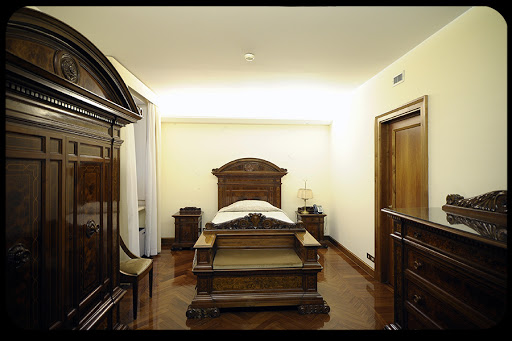Casa Santa Marta, the residence where Pope Francis has chosen to live rather than residing in the papal apartment in the Apostolic Palace, in a few months has become one of the most important places in the world, yet little is known about Pope Francis’ life inside its walls.
That is why the Vatican Watcher Aldo Maria Valli has written "With Francis in Santa Marta. A Journey into the Pope’s Home" (Ancora). Valli wanted to know more about this place, which together with the former monastery Mater Ecclesiae – which is located just a few minute’s walk away, and serves as the home of Pope Emeritus Benedict XVI – “is the epicenter of a true ‘revolution’ whose consequences shall perhaps be appreciated fully only by historians.”
One day last February, the author toured the residence after he was asked to produce a Tg1 Special on the first year of the pontificate of Pope Francis. “The idea,” he explained, “was to give our report a somewhat different angle than usual, by not only retracing the most important and meaningful events of such a new and exciting time, but by bringing together the voices of so many people who could give valuable testimony about the personality of Francis and his way of being the successor of Peter.”
“I already knew that Francis had a lifestyle characterized by simplicity and humility, but I never imagined such familiarity and friendship with the people who work at Santa Marta,” Valli said. “Everyone I listened to told me, in an extremely spontaneous and vivid way, that Francis is not a guest to serve and revere, but a friend and a father with whom each person has contact nearly every day and in exchange receive the gift of a great peace.”
Valli was then able to speak with the Pope himself, “and to touch firsthand his simplicity, his sincere and genuine way of relating to others, and also his openness and trust in those who, like myself—despite being a journalist and therefore so hopelessly intrusive—are greeted with such kindness and without a shadow of suspicion.”
From that experience, the journalist concluded that “the ‘conversion’ of the papacy of which Francis speaks in Evangelii Gaudium is not only an aim, much less a slogan or a merely theoretical matter; rather, it is already alive and underway, every day, even—and perhaps especially—when the Pope is away from the media spotlight.
“One thing is certain. When Francis decided to live at Santa Marta rather than at the apartment available to him in the Apostolic Palace, he introduced into his pontificate an innovation that is not only organizational. It also has a decisive scope on the pastoral and theological level,” and it made “an indelible mark on his pontificate,” “a mark that everyone can comprehend, in the name of the Franciscan evangelical poverty and simplicity, so much so that, according to many observers, had Bergoglio gone to live in the Apostolic Palace, he would not be the same Pope that we have seen, heard and known since March 13, 2013, the day of his election, and his teaching would not be as credible and effective.”
During the Conclave, Bergoglio had stayed in room 207, which was drawn by lot, as with all the other cardinals. Now, however, he lives in suite 201: about 50 square meters in all, with a study and bedroom . “The first room is a sitting area with a couple of chairs, a sofa, a desk, a bookcase and a crucifix. There’s absolutely no sign of luxury: absolute simplicity. The second room is a monastic sort of bedroom: a dark wooden bed, a wardrobe, a nightstand. The fluorescent lights make the environment a bit cold, like a boarding school room, but the Pope isn’t one to take notice.”
At Santa Marta, Valli adds, Bergoglio has found “a place that allows him to realize different objectives: to to give priority to the pastoral aspect of the mission of the Pope; to provide a practical example of how in his opinion homilies should be delivered (in Evangelii Gaudium he recommends that they be short and not seem like conferences or lectures); to remain firmly attached to the message of the Gospel; to reiterate that papal authority should be exercised in a lowly manner, without triumphalism; to express himself freely, avoiding curial quicksand; to keep himself from the risk of being contaminated by clericalism.”
A little point of interest about the napkin the Pope uses at meals. “When Francis realized that it was changed at every meal, three times a day, he said: ‘But what a waste! Why do we need to change a clean napkin?’. He then asked that it be changed only a couple of times a week, and now the Pope’s napkin is kept, as with all the other guests, in a sachet. Except that, in the case of the Pope’s sachet, there is embroidered ‘P. Francesco.’”

